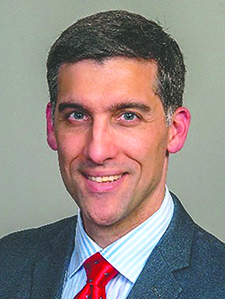As a resident in the otolaryngology–head and neck surgery department at Ohio State University in Columbus, Andrew Tompkins, MD, MBA, was surrounded by physicians and medical professors who had completed a fellowship program.
Dr. Tompkins, now an otolaryngologist at Ohio ENT & Allergy Physicians, knew he wouldn’t follow in their footsteps, at least not right away. He had made a commitment to join the military, so a fellowship right after residency was out of the question. But he felt the allure.
We may be at a saturation point where [the number of fellows is] as high as it’s going to get, but who knows what the future holds? —Andrew Tompkins, MD, MBA
“There was never any overt pressure with me, and I don’t necessarily know that there was with anyone in my residency, but I think it’s hard not to be taken in just with the exposure to the highly qualified, great surgeons I was surrounded by,” he said. “In any case, I probably couldn’t have gotten past the fact that I liked everything and wanted to be a generalist.” He never did pursue a fellowship.
Many physicians coming out of residency do end up taking a fellowship, but as the number of otolaryngologists doing so has risen in recent years, the field continues to consider the question of how many fellowship-trained subspecialists the field needs.
How Many Do We Need?
Dr. Tompkins is particularly thoughtful about the topic, as he chairs the American Academy of Otolaryngology–Head and Neck Surgery’s Workforce and Socioeconomic Task Force, which was created to identify the makeup of the otolaryngology workforce. The task force’s goal is to provide rich, transparent information about the field.
In a study published in 2021, researchers surveyed those taking the otolaryngology board oral exam. Over the eight-year study period from 2011 to 2019, 58% of respondents completed fellowships (Otolaryngol Head Neck Surg. 2021;165:655–661). In a comparison of individual years from the period, the percentage of respondents who completed a fellowship rose from 45.6% in 2011 to 61.5% in 2019. The most common fellowships were facial plastic surgery, pediatric otolaryngology, and head and neck surgery, in that order.
“We may be at a saturation point where [the number of fellows is] as high as it’s going to get, but who knows what the future holds?” Dr. Tompkins said. “I do think there is such a thing as too many fellows, but I don’t know what that number is.”
Generalists are especially needed for geographic areas with smaller populations that would not keep a fellowship trained subspecialist busy enough, as well as to fill in practice gaps in group practices that may have a few but not all subspecialties represented. —Cristina Cabrera-Muffly, MD
It’s an important question. “What if we had 100% of residents going into fellowship programs?” asked Dr. Tompkins. “That could lead to a mismatch between the training of a physician and the number of cases needed to maintain those skills. Both the patient and the doctor could suffer.”
Cristina Cabrera-Muffly, MD, the otolaryngology–head and neck surgery residency program director at the University of Colorado in Boulder, said that she hasn’t seen a trend of residents pursuing fellowships more often over the past 10 to 15 years. “It’s been an even mix,” she said.
“I think certain procedures such as pediatric airway surgeries, free flaps, and skull base procedures require the additional training and surgical volume associated with being fellowship trained,” said Dr. Cabrera-Muffly. “At the same time, a well-rounded residency education is more than enough to provide excellent care for patients with more common otolaryngology diseases.”
She also said that generalists aren’t destined to become a rarity. “Generalists are especially needed for geographic areas with smaller populations that would not keep a fellowship-trained subspecialist busy enough, as well as to fill in practice gaps in group practices that may have a few but not all subspecialties represented,” said Dr. Cabrera-Muffly, who herself is a generalist.
Stories from the Field
Christian Francom, MD, who completed a pediatric otolaryngology fellowship at the University of Colorado, said he pursued a fellowship because he enjoyed the complexity. Part of the decision was “wanting to be the final person to go to for some of these complicated issues.” He also thought it would help his ability to pursue academic medicine, which he did—he’s currently an assistant professor of otolaryngology–head and neck surgery at the University of Colorado, where he focuses on cleft lip and palate care.
The first person who came to Dr. Fancom’s mind as an influence during his education was Stephen Park, MD, director of facial plastic and reconstructive surgery at the University of Virginia in Charlottesville, where Dr. Francom attended medical school. “He was like a superhero to the medical students,” said Dr. Francom. “He would come in and have these fantastic surgeries and outcomes. There wasn’t a thing that he couldn’t do.”
At Ohio State where he did his residency, Dr. Francom did work with generalists, but he also worked with many fellowship-trained physicians. He never felt pressured to pursue a fellowship, however; instead, it was a decision based on his interests and discussions with his wife. “When I see a resident come through, I just want them to be the best that they can be,” said Dr. Francom. “And if that’s in a general practice, then great.”
Brian Cervenka, MD, who studied head and neck oncologic surgery and microvascular reconstruction in fellowship at Vanderbilt University in Nashville and is now on the faculty at the University of Colorado, said he knew early on that he would pursue a fellowship—it was just a question of whether it would be in head and neck oncology or neuro-otology and lateral skull base surgery. During his residency at the University of California, Davis, most of his exposure was to fellowship-trained faculty, who outnumbered general otolaryngology faculty by about 90 to 10, he said.
“I was very much influenced by the academic fellowship-trained head and neck microvascular surgeons that I worked with in residency,” said Dr. Cervenka. “And seeing their skill set and what they were able to offer patients was something I really wanted to replicate.”
In the otolaryngology–head and neck surgery program at the University of Colorado, there are 34 faculty, of whom 29—or 85%—are fellowship trained. Dr. Cervenka said it isn’t surprising that academic medical centers produce many fellowship-trained physicians, as it’s the role models with whom you interact every day who shape the type of practice you want to develop. “If there’s a need to produce more general otolaryngologists, one consideration is increasing the exposure in residency to those types of practices, as there are many great residents who would likely pursue this path if they were exposed to great role models in training,” he said.
Both he and Dr. Francom described high satisfaction with their work, saying that even within their subspecialties, there’s a wide variety in the types of cases they see. Dr. Francom believes this holds true for other fellowship-trained physicians who have gone into generalist practice. In his conversations with them, they say they’re happier in their jobs as well.
William Blythe, MD, a general otolaryngologist at East Alabama Ear, Nose & Throat in Opelika, believes the otolaryngology field doesn’t need as much subspecialty as it’s currently producing. “I think we have way too many subspecialists,” he said, adding that there isn’t enough subspecialty pathology and surgery to support it. “I think what you’re seeing quite commonly is physicians with subspecialty training who are primarily doing general otolaryngology and then sprinkling in or enhancing their practice with their subspeciality area.”
Dr. Blythe said that a physician who is fellowship trained and who subspecializes could lose the skill set they developed while in residency or could lose their fellowship-acquired skills if they do mostly general otolaryngology. He also noted that otolaryngology is already “a very small surgical subspecialty” that recruits the “absolute best” people out of medical school. He acknowledged that fellowships are needed to learn how to handle less-common, highly complex cases. But fellowships aren’t needed for standard cases, and Dr. Blythe cautioned that he doesn’t believe a fellowship should be used as a marketing strategy, for instance, to suggest that a fellowship-trained otolaryngologist “can take out tonsils better than I can. They can certainly do advanced pediatric stuff—laryngotracheal reconstructions and taking care of neonates with airway obstruction—better than I can,” he said.
What the field needs, said Dr. Blythe, are more otolaryngologists who are very good at about 90% of the procedures that come through the door. “You really need very smart, good doctors at the open end of the funnel,” he said. “All of medicine would be better if we did that, if we had the smartest, brightest, most energetic doctors at the open end of the funnel.”
Dr. Tompkins said that residents should get a well-rounded exposure to otolaryngology, suggesting that exposure to private-practice general otolaryngology in residency may be too limited in many programs. “Whatever residents decide, I think they should do it with full transparency. I don’t think that to this point the decisions that have gone into choosing a fellowship have necessarily been made in the most transparent way possible,” he said.
Transparent numbers on the needs of the otolaryngology field, he hopes, will help residents make fully informed decisions on how to proceed in their careers and enable residency programs to shape the types of work to which their residents are exposed. Such transparent data, he said, is the only way to make changes in the subspecialization trend—if such changes are needed.
Thomas R. Collins is a freelance medical writer based in Florida.
Fellowship-Trained Residency Faculty
ENTtoday asked a random sampling of 20 U.S. otolaryngology residency programs how many of their faculty members are fellowship trained. We received responses from seven program directors, from large and small programs.
They reported that 152 of 184 faculty members, or about 83%, are fellowship trained, indicating that residents get far more exposure to work done by fellowship-trained physicians than by generalists.

